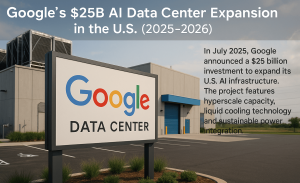With the explosion of artificial intelligence (AI) applications, particularly generative AI and large language models (LLMs) cloud providers are under intense pressure to scale their infrastructure to support these compute-intensive workloads. In response, Google announced in July 2025 a landmark investment of $25 billion over the next two years to build and expand AI-ready data centers across key U.S. states, marking one of the largest capital commitments to AI infrastructure by a tech company to date.
This move comes in parallel with similar multi-billion-dollar investments by Microsoft, Nvidia, and Meta, all racing to build the next generation of hyperscale AI data centers capable of supporting real-time inference, model training, and data-intensive AI applications.

Scope of the Investment
Google’s $25 billion initiative encompasses:
-
New Construction: Establishment of multiple new hyperscale data center campuses across the Midwest, Southern states, and the Pacific Northwest.
-
Upgrades to Existing Infrastructure: Retrofitting current facilities with AI-optimized hardware, including custom Tensor Processing Units (TPUs) and high-performance GPUs.
-
High-Density Rack Deployment: Enabling rack power densities of up to 60 kW to accommodate the massive compute demands of LLM training.
-
Advanced Cooling Solutions: Implementation of liquid cooling systems, including direct-to-chip cooling and rear-door heat exchangers, to manage heat dissipation in high-density environments.
-
Sustainable Energy Integration: Partnering with utility providers to power data centers with renewable energy, including solar, wind, and geothermal sources, in alignment with Google’s 2030 goal to operate on carbon-free energy 24/7.
Strategic Objectives
-
Support AI Ecosystem: Provide the infrastructure backbone for its AI-driven services, including GoogleCloud AI, Gemini models, Search enhancements, and AI Workspace tools.
-
Market Leadership: Solidify Google’s position as a global leader in AI cloud services, competing directly with Amazon AWS and Microsoft Azure.
-
Accelerate Generative AI Training: Handle massive model training tasks efficiently, reducing time-to-market for generative AI solutions and APIs.
-
Enhance Latency-Sensitive Applications: Expand edge capabilities to better support applications like real-time translation, autonomous systems, and voice assistants.
-
Sustainability Commitment: Drive innovation in green AI data centers, reducing environmental footprint while scaling performance.
Technological Highlights
-
Custom Silicon: Deployment of the latest Google TPU v6 and next-gen AI accelerators for enhanced throughput and energy efficiency.
-
Interconnect Fabric: Use of ultra-low-latency networking architecture with AI-optimized interconnects and 100/400 Gbps Ethernet.
-
Liquid Cooling: First-time widespread adoption of liquid-cooled AI clusters for model training workloads in Google’s North American centers.
-
Security Architecture: Zero-trust security implementation with hardware-based encryption and AI-driven threat detection mechanisms.
Geographic Focus Areas
Although Google has not publicly disclosed every site, the initial wave of investments is focused on:
-
Texas and Oklahoma – for access to affordable land and power.
-
Iowa and Ohio – benefiting from existing infrastructure and green energy contracts.
-
Oregon and Nevada – for proximity to Google’s existing fiber network and low-latency West Coast coverage.
-
Additional expansion is rumored in North Carolina, Georgia, and New Mexico.
Impact on the U.S. AI Data Center Market
-
Market Share Leadership: This move is expected to elevate Google’s market share in the U.S. AI data center space from ~22% to over 30% by 2027.
-
Job Creation: The project is forecasted to create over 20,000 direct and indirect jobs in construction, engineering, operations, and cloud services.
-
Infrastructure Ripple Effect: Google’s investment is catalyzing parallel infrastructure development in fiber optics, clean energy projects, and AI R&D ecosystems.
-
Benchmark for Green AI: This initiative sets a precedent for eco-conscious hyperscale growth, with early adoption of AI energy efficiency metrics (like PUE for AI training clusters).
Challenges & Mitigation
| Challenge | Mitigation Strategy |
|---|---|
| Power demands and grid pressure | Partnering with local utilities for green energy offsets, smart grid integration |
| Land acquisition and community resistance | Local stakeholder engagement, community investment funds |
| Cooling for high-density racks | Liquid immersion and direct-to-chip cooling technologies |
| Regulatory compliance | Ensuring all builds meet federal/state environmental and data security regulations |
Google’s $25 billion investment in AI data centers is not just a capital infusion—it’s a strategic move to dominate the next era of intelligent computing infrastructure. This project reflects the broader trend in the AI data centers market: moving toward sustainable hyperscale expansion, AI-specific hardware deployment, and cloud-native AI service delivery. As AI models become more complex and data-intensive, Google’s proactive infrastructure strategy may prove decisive in maintaining its leadership in the AI-driven digital economy.